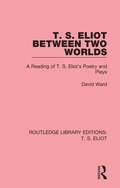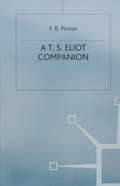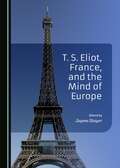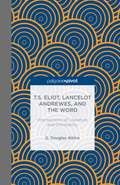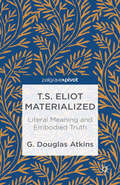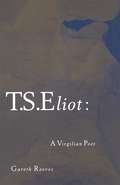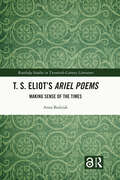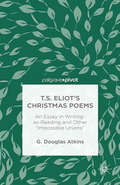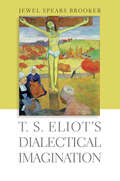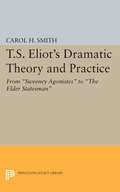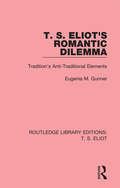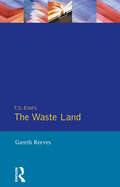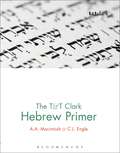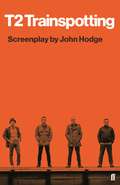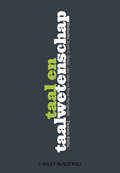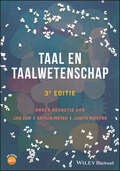- Table View
- List View
T. S. Eliot Between Two Worlds: A Reading of T. S. Eliot's Poetry and Plays (Routledge Library Editions: T. S. Eliot)
by David WardThe basis of this critical examination of Eliot’s work, first published in 1973, is the investigation of his transmutation of this and other philosophical, mythological and religious motives into the textures of his verse. This book focuses on Eliot’s peculiar eclectic approach to what he described as ‘the Tradition’. It also recognises the fact that Eliot, for all his attempts at universality, was a product of time and place, and gives an account of the way in which his education and experience shaped his most important interests. This title will be of interest to students of literature.
T. S. Eliot Between Two Worlds: A Reading of T. S. Eliot's Poetry and Plays (Routledge Library Editions: T. S. Eliot #10)
by David WardThe basis of this critical examination of Eliot’s work, first published in 1973, is the investigation of his transmutation of this and other philosophical, mythological and religious motives into the textures of his verse. This book focuses on Eliot’s peculiar eclectic approach to what he described as ‘the Tradition’. It also recognises the fact that Eliot, for all his attempts at universality, was a product of time and place, and gives an account of the way in which his education and experience shaped his most important interests. This title will be of interest to students of literature.
T. S. Eliot, France, And The Mind Of Europe
by Jayme StayerIn late 1910, after graduating from Harvard with a master’s degree in philosophy, the young T. S. Eliot headed across the Atlantic for a year of life and study in France, a country whose poets had already deeply affected his sensibility. His short year there was to change him even more decisively, as he rubbed up against the artistic, philosophical, psychological and political currents of early-century Paris. The absorbent mind of Eliot – as shaped by what he later termed “the mind of Europe” – was a node in this interlocking grid of influences. As there is no understanding T. S. Eliot without considering the impact of French art and thought on his development, this volume serves both as a centennial commemoration of Eliot’s year in Paris and as a reconsideration of the role of France and, more widely, Europe, as they bore on his growth as an artist and critic. Most scholarship on Eliot and France has focused on Eliot’s relationship to the nineteenth-century Symbolists and to the philosophy of Henri Bergson. This old frame of reference is broken apart in favor of a much wider field that still takes Paris as its center but reaches across national borders. The volume is divided into two overlapping sections: the first, “Eliot and France,” focuses on French authors and trends that shaped Eliot and on the personal experiences in Paris that are legible in his artistic development. The second section, “Eliot and Europe,” situates Eliot in a broader matrix, including Anglo-French literary theory, evolutionary sociology, and German influences. Contributors include several highly respected names in the field of modernist studies – including Jean-Michel Rabaté, Jewel Spears Brooker, and Joyce Wexler – as well as a number of well-established Eliot scholars. Reflecting multiple perspectives, this volume does not offer a single, revisionist take on French and European influence in Eliot’s work. Rather, it circles back to familiar territory, deepening and complicating the accepted narratives. It also opens up new veins of inquiry from unexpected sources and understudied phenomena, drawing on the recently published letters and essays that are currently remapping the field of Eliot studies.
T.S. Eliot, Lancelot Andrewes, and the Word: Intersections Of Literature And Christianity
by G. AtkinsWith special attention to the poems For Lancelot Andrewes, Journey of the Magi, and Ash-Wednesday , G. Douglas Atkins offers an exciting new analysis of T.S. Eliot's debt to the seventeenth-century churchman Lancelot Andrewes and his theories of reading and writing texts.
T.S. Eliot Materialized: Literal Meaning And Embodied Truth
by G. AtkinsBy reading T.S. Eliot literally and laterally, and attending to his intra-textuality, G. Douglas Atkins challenges the familiar notion of Eliot as bent on escaping this world for the spiritual. This study culminates in the necessary, but seemingly impossible, union of reading and writing, literature and commentary.
The T. S. Eliot Studies Annual: Volume 3 (Clemson University Press)
by Julia DanielThe T. S. Eliot Studies Annual is the leading venue for the critical reassessment of Eliot’s life and work in light of the ongoing publication of his letters, critical volumes of his complete prose, the new edition of his complete poems, and the forthcoming critical edition of his plays. All critical approaches are welcome, as are essays pertaining to any aspect of Eliot’s work as a poet, critic, playwright, or editor. Volume 3 features two special forums on “Eliot and Green Modernism,” edited by Julia E. Daniel, and “First Readings of the Eliot–Hale Archive,” edited by John Whittier-Ferguson and Frances Dickey. John D. Morgenstern, General Editor Editorial Advisory Board: Ronald Bush, University of Oxford David E. Chinitz, Loyola University Chicago Anthony Cuda, University of North Carolina–Greensboro Robert Crawford, University of St Andrews Frances Dickey, University of Missouri John Haffenden, University of Sheffield Benjamin G. Lockerd, Grand Valley State University Gail McDonald, Goldsmiths, University of London Gabrielle McIntire, Queen’s University Jahan Ramazani, University of Virginia Christopher Ricks, Boston University Ronald Schuchard, Emory University Vincent Sherry, Washington University at St. Louis
The T. S. Eliot Studies Annual: Volume 2 (Clemson University Press)
by John MorgensternThe T. S. Eliot Studies Annual strives to be the leading venue for the critical reassessment of Eliot’s life and work in light of the ongoing publication of his letters, critical volumes of his complete prose, the new edition of his complete poems, and the forthcoming critical edition of his plays. All critical approaches are welcome, as are essays pertaining to any aspect of Eliot’s work as a poet, critic, playwright, editor, or foremost exemplar of literary modernism. Editorial Advisory Board:Ronald Bush, University of OxfordDavid E. Chinitz, Loyola University ChicagoAnthony Cuda, University of North Carolina–GreensboroRobert Crawford, University of St AndrewsFrances Dickey, University of MissouriJohn Haffenden, University of SheffieldBenjamin G. Lockerd, Grand Valley State UniversityGail McDonald, Goldsmiths, University of LondonGabrielle McIntire, Queen’s UniversityJahan Ramazani, University of VirginiaChristopher Ricks, Boston UniversityRonald Schuchard, Emory UniversityVincent Sherry, Washington University at St. Louis
The T. S. Eliot Studies Annual: Volume 2 (Clemson University Press)
The T. S. Eliot Studies Annual strives to be the leading venue for the critical reassessment of Eliot’s life and work in light of the ongoing publication of his letters, critical volumes of his complete prose, the new edition of his complete poems, and the forthcoming critical edition of his plays. All critical approaches are welcome, as are essays pertaining to any aspect of Eliot’s work as a poet, critic, playwright, editor, or foremost exemplar of literary modernism. John D. Morgenstern, General Editor Editorial Advisory Board: Ronald Bush, University of Oxford David E. Chinitz, Loyola University Chicago Anthony Cuda, University of North Carolina–Greensboro Robert Crawford, University of St Andrews Frances Dickey, University of Missouri John Haffenden, University of Sheffield Benjamin G. Lockerd, Grand Valley State University Gail McDonald, Goldsmiths, University of London Gabrielle McIntire, Queen’s University Jahan Ramazani, University of Virginia Christopher Ricks, Boston University Ronald Schuchard, Emory University Vincent Sherry, Washington University at St. Louis
T. S. Eliot’s Ariel Poems: Making Sense of the Times (Routledge Studies in Twentieth-Century Literature)
by Anna BudziakT. S. Eliot once stated that the supreme poet "in writing himself, writes his time". In saying that, he honoured Dante and Shakespeare, but this pithy remark fittingly characterises his own work, including The Ariel Poems, with which he promptly and pointedly responded to the problems of his times. Published with unwavering regularity, a poem a year, the Ariels were composed in the period when Eliot was mainly writing prose; and, like his prose, they reverberated with diverse contemporary issues ranging from the revision of the Book of Common Prayer to the translations of Heidegger to the questions of leadership and populism. In order to highlight the poems' historical specificity, this study seeks to outline the constellations of thought connecting Eliot’s poetry and prose. In addition, it attempts to expose the Ariels’ shared arc of meaning, an unobtrusive incarnational metaphor determining the perspective from which they propose an unorthodox understanding of the epoch— an underlying pattern of thought bringing them together into a conceptually discrete set. This is the first study that both universalizes and historicises the series, striving to disclose the regular without suppressing the random. Approaching the series as a system of orderly disorder, the notion very much at home with chaos theory, it suggests new intellectual contexts, offering interpretations that are either fresh, or significantly reangled.
T. S. Eliot’s Ariel Poems: Making Sense of the Times (Routledge Studies in Twentieth-Century Literature)
by Anna BudziakT. S. Eliot once stated that the supreme poet "in writing himself, writes his time". In saying that, he honoured Dante and Shakespeare, but this pithy remark fittingly characterises his own work, including The Ariel Poems, with which he promptly and pointedly responded to the problems of his times. Published with unwavering regularity, a poem a year, the Ariels were composed in the period when Eliot was mainly writing prose; and, like his prose, they reverberated with diverse contemporary issues ranging from the revision of the Book of Common Prayer to the translations of Heidegger to the questions of leadership and populism. In order to highlight the poems' historical specificity, this study seeks to outline the constellations of thought connecting Eliot’s poetry and prose. In addition, it attempts to expose the Ariels’ shared arc of meaning, an unobtrusive incarnational metaphor determining the perspective from which they propose an unorthodox understanding of the epoch— an underlying pattern of thought bringing them together into a conceptually discrete set. This is the first study that both universalizes and historicises the series, striving to disclose the regular without suppressing the random. Approaching the series as a system of orderly disorder, the notion very much at home with chaos theory, it suggests new intellectual contexts, offering interpretations that are either fresh, or significantly reangled.
T.S. Eliot’s Christmas Poems: An Essay in Writing-as-Reading and Other “Impossible Unions”
by G. AtkinsThis is the first full-scale analysis of T.S. Eliot's six "Ariel Poems" as Christmas poems. Through close readings, Atkins argues that these poems considered together emerge as clearly related representations of the "impossible union" that occurred in the Incarnation.
T. S. Eliot's Dialectical Imagination: The Dialectical Imagination (Hopkins Studies in Modernism)
by Jewel Spears BrookerThe thought-tormented characters in T. S. Eliot;€™s early poetry are paralyzed by the gap between mind and body, thought and action. The need to address this impasse is part of what drew Eliot to philosophy, and the failure of philosophy to appease his disquiet is the reason he gave for abandoning it. In T. S. Eliot;€™s Dialectical Imagination, Jewel Spears Brooker argues that two of the principles that Eliot absorbed as a PhD student at Harvard and Oxford were to become permanent features of his mind, grounding his lifelong quest for wholeness and underpinning most of his subsequent poetry. The first principle is that contradictions are best understood dialectically, by moving to perspectives that both include and transcend them. The second is that all truths exist in relation to other truths. Together or in tandem, these two principles;¢;‚¬;€?dialectic and relativism;¢;‚¬;€?constitute the basis of a continual reshaping of Eliot;€™s imagination. The dialectic serves as a kinetic principle, undergirding his impulse to move forward by looping back, and the relativism supports his ingrained ambivalence. Brooker considers Eliot;€™s poetry in three blocks, each represented by a signature masterpiece: "The Love Song of J. Alfred Prufrock," The Waste Land, and Four Quartets. She correlates these works with stages in the poet;€™s intellectual and spiritual life: disjunction, ambivalence, and transcendence. Using a methodology that is both inductive;¢;‚¬;€?moving from texts to theories;¢;‚¬;€?and comparative;¢;‚¬;€?juxtaposing the evolution of Eliot;€™s mind as reflected in his philosophical prose and the evolution of style as seen in his poetry;¢;‚¬;€?Brooker integrates cultural and biographical contexts. The first book to read Eliot;€™s poems alongside all of his prose and letters, T. S. Eliot;€™s Dialectical Imagination will revise received readings of his mind and art, as well as of literary modernism.
T. S. Eliot's Dialectical Imagination (Hopkins Studies in Modernism)
by Jewel Spears BrookerThe thought-tormented characters in T. S. Eliot;€™s early poetry are paralyzed by the gap between mind and body, thought and action. The need to address this impasse is part of what drew Eliot to philosophy, and the failure of philosophy to appease his disquiet is the reason he gave for abandoning it. In T. S. Eliot;€™s Dialectical Imagination, Jewel Spears Brooker argues that two of the principles that Eliot absorbed as a PhD student at Harvard and Oxford were to become permanent features of his mind, grounding his lifelong quest for wholeness and underpinning most of his subsequent poetry. The first principle is that contradictions are best understood dialectically, by moving to perspectives that both include and transcend them. The second is that all truths exist in relation to other truths. Together or in tandem, these two principles;¢;‚¬;€?dialectic and relativism;¢;‚¬;€?constitute the basis of a continual reshaping of Eliot;€™s imagination. The dialectic serves as a kinetic principle, undergirding his impulse to move forward by looping back, and the relativism supports his ingrained ambivalence. Brooker considers Eliot;€™s poetry in three blocks, each represented by a signature masterpiece: "The Love Song of J. Alfred Prufrock," The Waste Land, and Four Quartets. She correlates these works with stages in the poet;€™s intellectual and spiritual life: disjunction, ambivalence, and transcendence. Using a methodology that is both inductive;¢;‚¬;€?moving from texts to theories;¢;‚¬;€?and comparative;¢;‚¬;€?juxtaposing the evolution of Eliot;€™s mind as reflected in his philosophical prose and the evolution of style as seen in his poetry;¢;‚¬;€?Brooker integrates cultural and biographical contexts. The first book to read Eliot;€™s poems alongside all of his prose and letters, T. S. Eliot;€™s Dialectical Imagination will revise received readings of his mind and art, as well as of literary modernism.
T.S. Eliot's Dramatic Theory and Practice: From Sweeney Agonistes to the Elder Statesman
by Carol H. SmithAlthough there have been innumerable studies of T. S. Eliot, this is the first to examine closely the changes in his dramatic practice and to relate them to his artistic and intellectual development. Professor Smith finds Eliot's dramatic theory rooted in his conception of the need for order in religion and art; she traces this concept as it evolved from the overtly religious The Rock and Murder in the Cathedral through such symbolic drawing-room plays as The Family Reunion, The Cocktail Party, and The Confidential Clerk, to Eliot’s latest study of human and divine love in The Elder Statesman. Carol H. Smith explores Eliot’s interest in the jazz rhythms of the English music hall, in the mythical method of Yeats and Joyce, and in the work of the Cambridge School of Classical Anthropology.Originally published in 1963.The Princeton Legacy Library uses the latest print-on-demand technology to again make available previously out-of-print books from the distinguished backlist of Princeton University Press. These editions preserve the original texts of these important books while presenting them in durable paperback and hardcover editions. The goal of the Princeton Legacy Library is to vastly increase access to the rich scholarly heritage found in the thousands of books published by Princeton University Press since its founding in 1905.
T. S. Eliot's Romantic Dilemma: Tradition's Anti-Traditional Elements (Routledge Library Editions: T. S. Eliot)
by Eugenia M. GunnerThe fact that Eliot disapproved of Romanticism is clear from his critical essays, where he often appears to reject it absolutely. However, Eliot’s understanding of the term and his appreciation of literature developed and altered greatly from his adolescence to his years of scholarly study, yet he was never unable to dismiss Romanticism entirely as a critical issue. This study, first published in 1985, analyses Eliot’s approach and criticism to Romanticism, with an analysis of The Waste Land, adding to the layers of its meaning, context and content to the poem. This title will be of interest to students of literature.
T. S. Eliot's Romantic Dilemma: Tradition's Anti-Traditional Elements (Routledge Library Editions: T. S. Eliot #4)
by Eugenia M. GunnerThe fact that Eliot disapproved of Romanticism is clear from his critical essays, where he often appears to reject it absolutely. However, Eliot’s understanding of the term and his appreciation of literature developed and altered greatly from his adolescence to his years of scholarly study, yet he was never unable to dismiss Romanticism entirely as a critical issue. This study, first published in 1985, analyses Eliot’s approach and criticism to Romanticism, with an analysis of The Waste Land, adding to the layers of its meaning, context and content to the poem. This title will be of interest to students of literature.
T. S. Elliot's The Waste Land
by Gareth ReevesThis work argues that although "The Waste Land" demands close reading, the spirit of the old New Criticism works with inappropriate assumptions about unity and closed form. Many critics have tried to fix the text, to find hidden narratives and plots, spiritual guests and allegories of salvation. Instead, this reading sees the poem as resolutely open-ended, supporting this view with recent developments in Reader-Response criticism and Reception Theory. The study focuses on the way poetry sounds (or does not sound, cannot be sounded). It concentrates on syntax, lineation and intonation. It also brings out the presence of the muted voices of wronged women in a work often called misogynistic.
T. S. Elliot's The Waste Land
by Gareth ReevesThis work argues that although "The Waste Land" demands close reading, the spirit of the old New Criticism works with inappropriate assumptions about unity and closed form. Many critics have tried to fix the text, to find hidden narratives and plots, spiritual guests and allegories of salvation. Instead, this reading sees the poem as resolutely open-ended, supporting this view with recent developments in Reader-Response criticism and Reception Theory. The study focuses on the way poetry sounds (or does not sound, cannot be sounded). It concentrates on syntax, lineation and intonation. It also brings out the presence of the muted voices of wronged women in a work often called misogynistic.
The T&T Clark Hebrew Primer
by A. A. Macintosh C. L. EngleLearning Biblical Hebrew can be extremely difficult. Here at last is a book designed to work in conjunction with the many Hebrew Grammars available in order to break this complex language down into bite-size chunks for revision and consolidation of key aspects of grammar, as well as vocabulary. A.A. Macintosh and C.L. Engle combine insights from teaching Hebrew in both the United States and Europe, and between them bring some fifty years of experience of teaching Hebrew to undergraduate students to this clearly structured book.
T2 Trainspotting
by John HodgeFirst there is an opportunity, then there is a betrayal.Twenty years have gone by.Much has changed but just as much remains the same.Mark Renton returns to the only place he can ever call home. They are waiting for him, of course: Spud, Sick Boy, and Frank Begbie. But they are not alone. Other old friends are waiting too: sorrow, loss, joy, vengeance, hatred, friendship, love, longing, fear, regret, diamorphine, self-destruction and mortal danger, they are all lined up to welcome him, ready to join the dance. Mark Renton returns, to the chaos of life and death.
Taal en Taalwetenschap
by Anne Baker Jan Don Kees HengeveldDit boek geeft een brede introductie in de taalwetenschap in al haar facetten. De structuur van taal krijgt uiteraard ruime aandacht, maar ook de taalgebruiker en de taalgemeenschap komen uitgebreid aan bod. • Voorbeelden uit een groot aantal talen. • Niet theorie-gebonden. • Geschikt voor probleem-gestuurd onderwijs. • Docentenhandleiding beschikbaar op beveiligde website.
Taal en Taalwetenschap
by Anne E. Baker Jan Don Kees HengeveldDit boek geeft een brede introductie in de taalwetenschap in al haar facetten. De structuur van taal krijgt uiteraard ruime aandacht, maar ook de taalgebruiker en de taalgemeenschap komen uitgebreid aan bod. • Voorbeelden uit een groot aantal talen. • Niet theorie-gebonden. • Geschikt voor probleem-gestuurd onderwijs. • Docentenhandleiding beschikbaar op beveiligde website.
Taal en Taalwetenschap
by Jan DonDe nieuwste editie van de toonaangevende bestseller in de categorie studieboeken Nederlandse taal en taalkunde In de derde herziene editie van Taal en Taalwetenschapgeefteen team van gerenommeerdetaalkundigeneen bredeinleiding inde belangrijkste thema'svan de taalwetenschap. Dit studieboek behandeltalle taalkundige deelgebieden, waaronderfonetiek, fonologie, morfologie, syntaxis, semantiek, discourse, en pragmatiek. De lezer maakt kennis met fundamentele begrippen en inzichten in het vakgebied, dieop toegankelijke wijze worden toegelicht aan de hand van voorbeelden uit allerlei talen. Ook is er aandacht voor meer toegepaste onderwerpen waarbij de taalgebruiker en taalgemeenschap centraal staan, zoalstaalverwerving, sociolinguïstiek, historische taalkunde en taalstoornissen. Deze jongste editie is grondig herzien om recente ontwikkelingen in het vakgebied recht te doen. Zo wordt de bespreking van taalverwerking versterkt door interdisciplinair onderzoek uit de neuro- en computerwetenschappen, en komen nieuwe inzichten vanuit de Optimaliteitstheorie en ander fonologisch onderzoek aan bod. In het boek kunnen lezers niet alleen zelftests vinden, maar ook: Uitgebreide introducties aan taal en taalvermogen om de lezer te gronden in noodzakelijke fundamentele kennis van het vakgebied Beschouwingen van discourse, syntaxis, woorden, fonologie, talen, en taalgemeenschappen Een toegankelijke schrijfstijl en vele voorbeelden om de betrokkenheid van de lezer te stimuleren, ideaal voor hen die nieuw met het onderwerp zijn Nieuwe oefeningen en samenvattingenen een begeleidende website die aanvullende onderwijsmaterialen voor de docent bevat, zoals modelantwoorden, onderwijssuggesties en aanvullende audio- en videobestanden Taal en Taalwetenschap is bij uitstek geschikt voor gebruik ininleidende cursussen in de taalwetenschap, maar ook voor zelfstudie: de bestseller is een onmisbaar naslagwerk dat een breed overzicht geeft van taal en taalwetenschap in al haar facetten.
